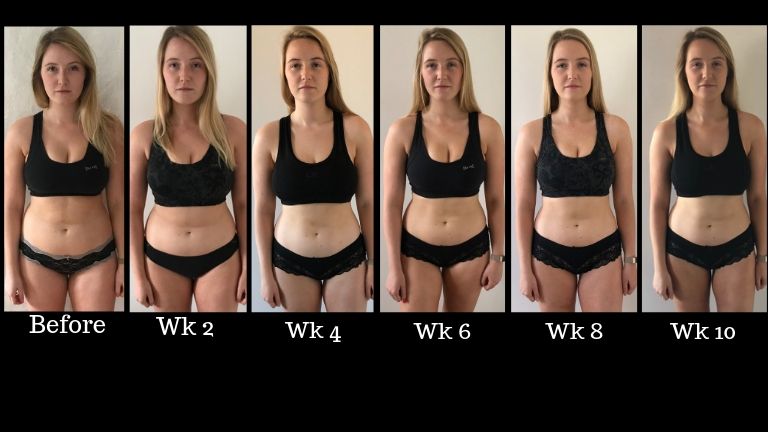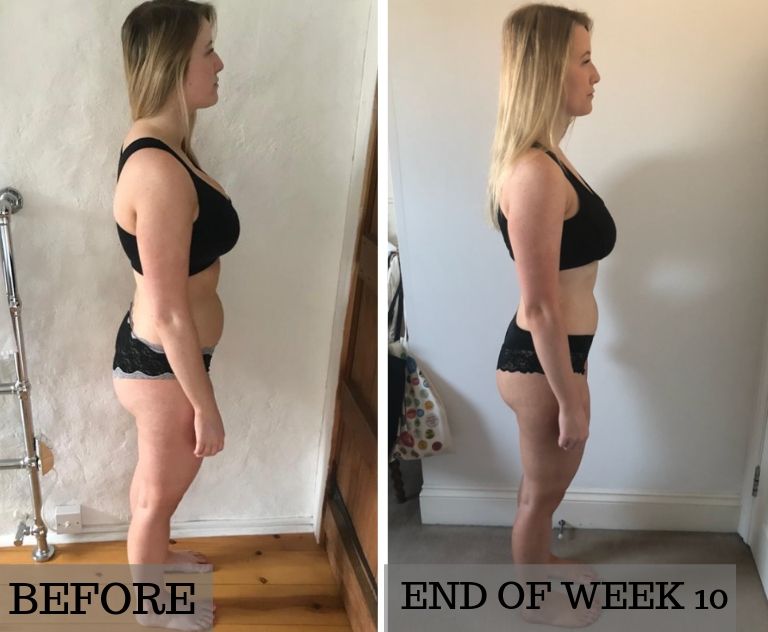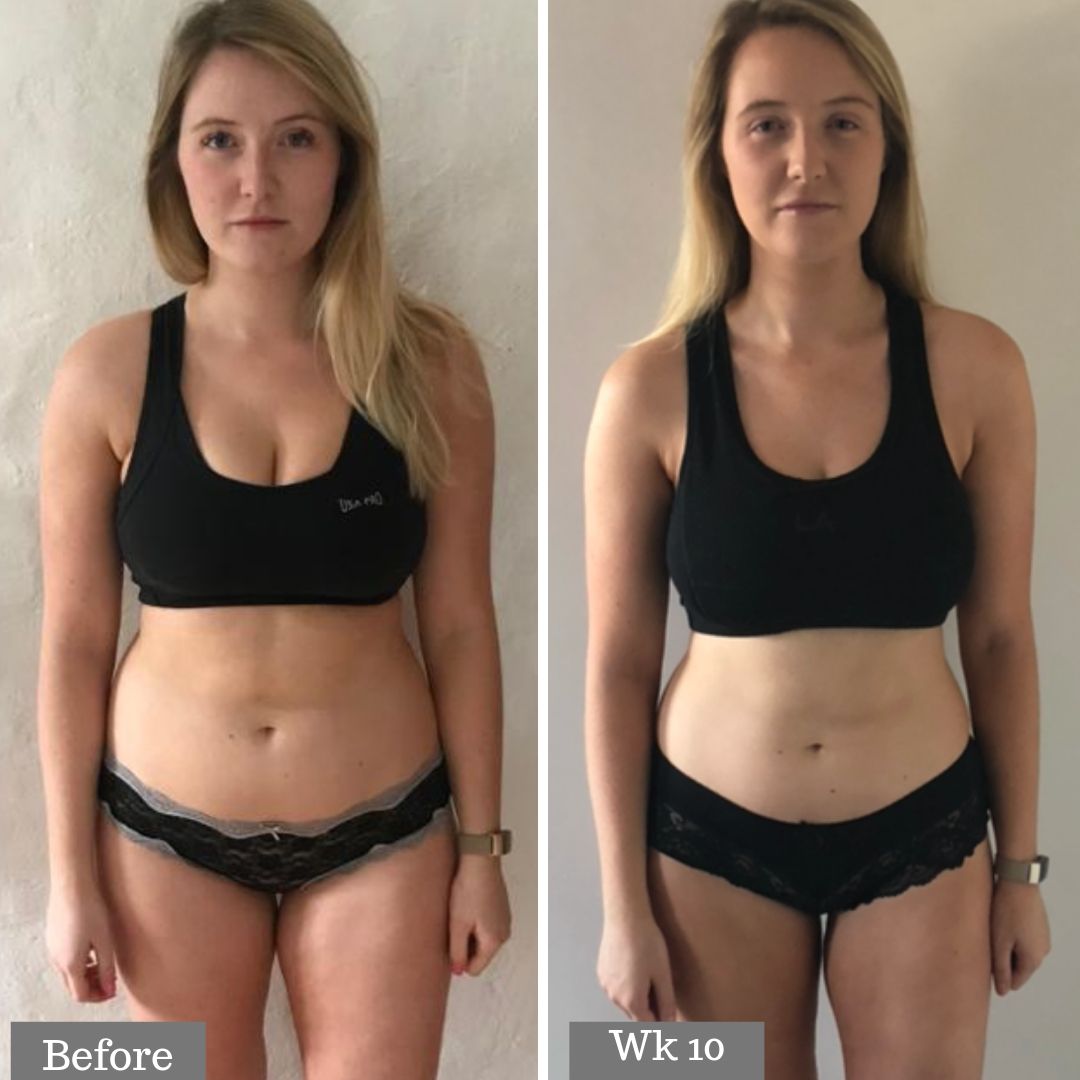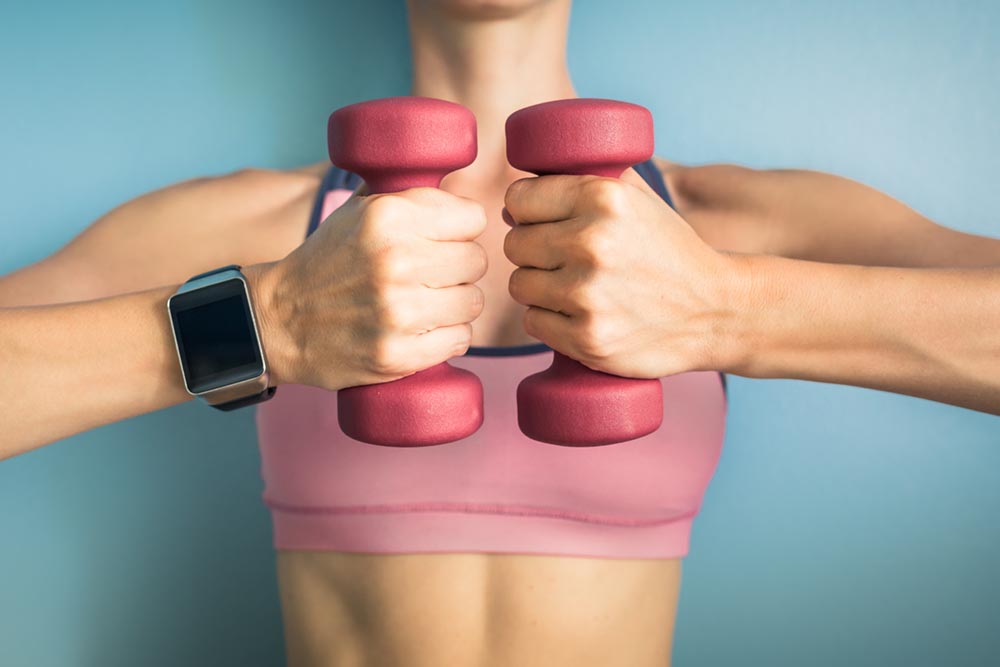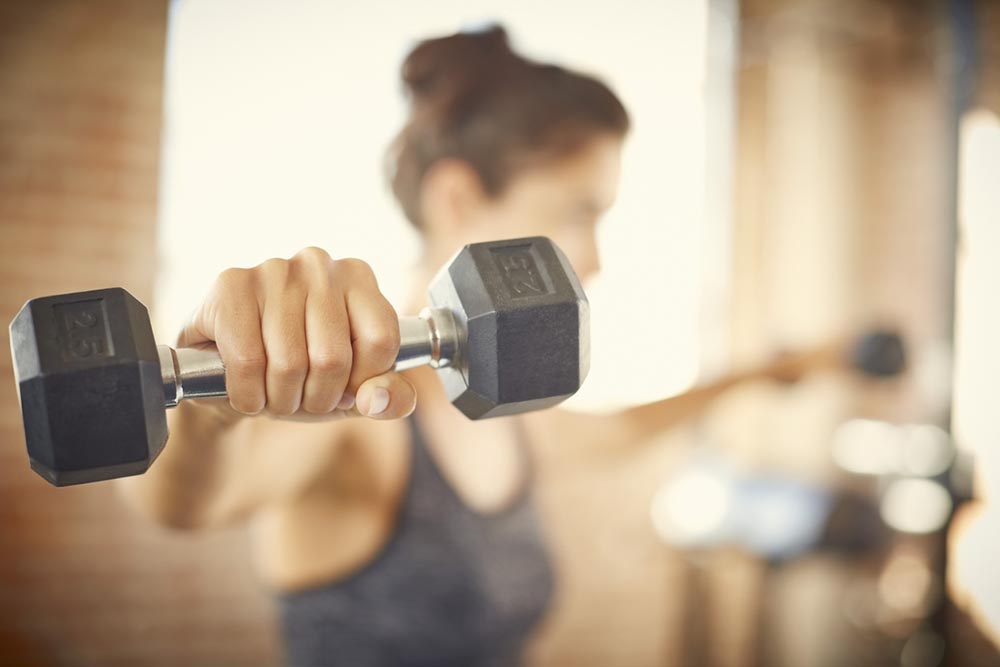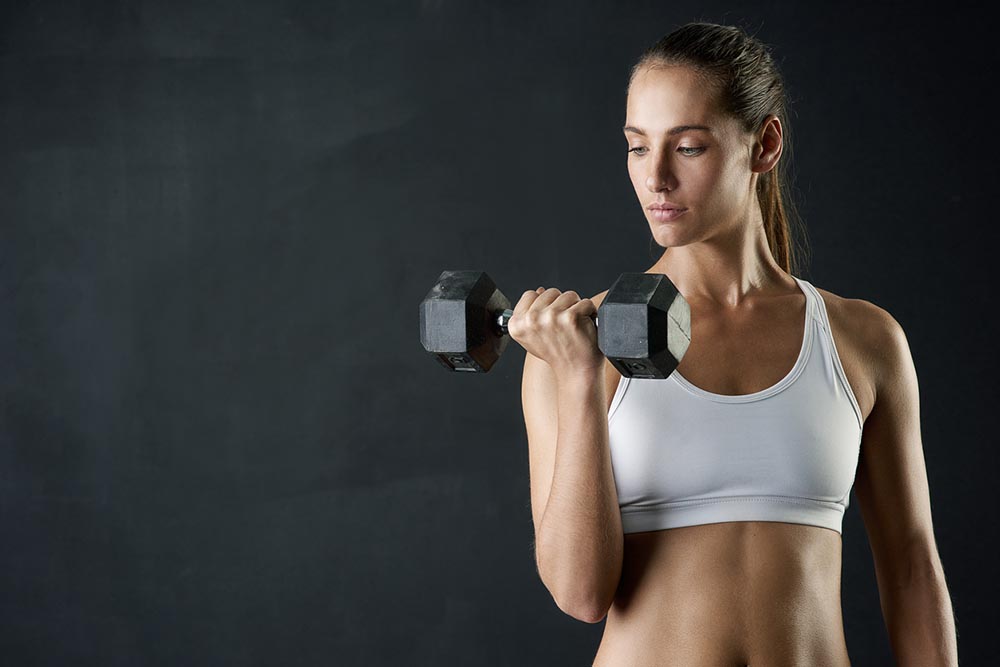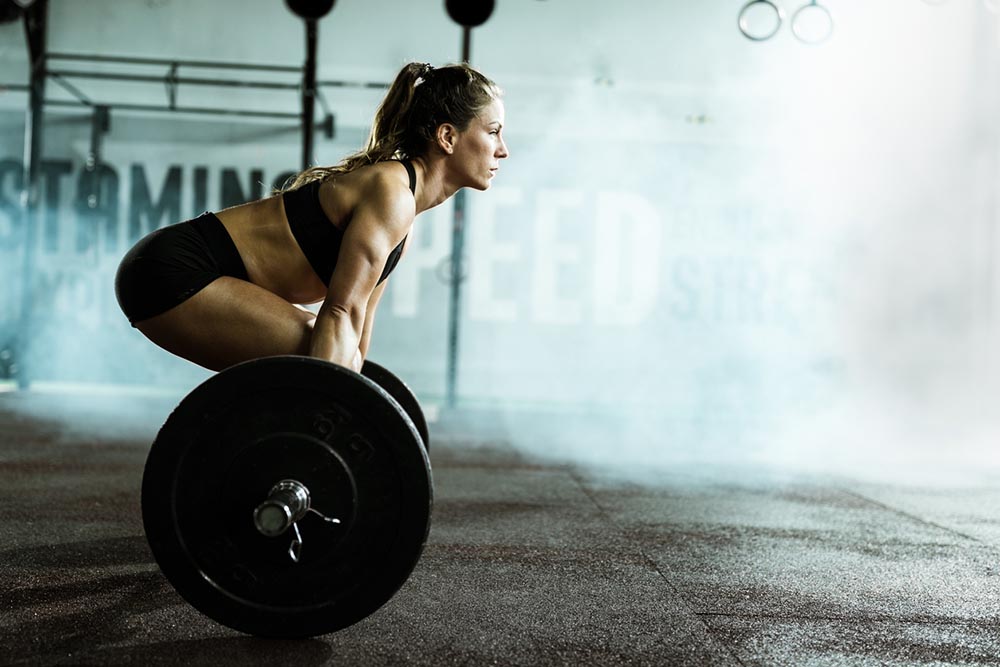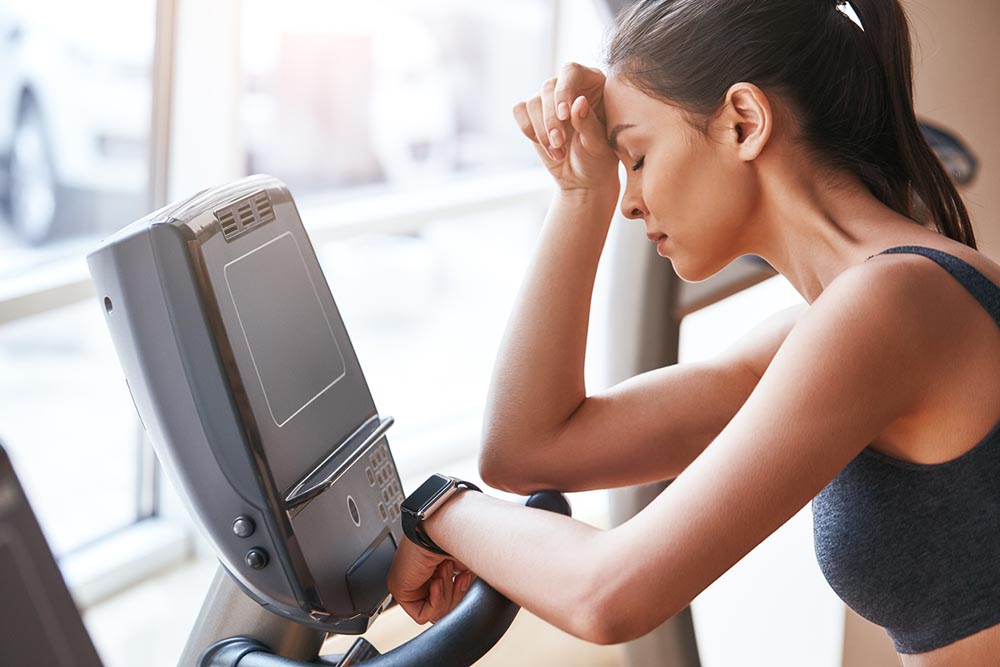Understanding the role hormones play in exercise and weight loss is absolutely essential to getting the results you want – as Olivia Hartland-Robbins, who has now lost 6% body fat, learned
It’s week ten of my body transformation at Transition Zone, and as you can all see from my results this week, it’s still bloomin’ working!
I mean weirdly, a few measurements have gone up – I totally blame time of the month hormones – but my body fat percentage is still going down and that’s all that matters…
| Before | Week 1 | Week 2 | Week 3 | Week 4 | Week 5 | Week 6 | Week 7 | Week 8 | Week 9 | Week 10 | |
| Weight kg | 68.9 | 67.4 | 66.3 | 65.5 | 64.8 | 64.8 | 64.5 | 63.8 | 63.2 | 63.4 | 64.4 |
| Body Fat % | 27.0 | 25.8 | 24.2 | 24.6 | 23.2 | 22.8 | 22.4 | 23.1 | 22.7 | 21.9 | 21.1 |
| Hips cm | 107 | 107 | 104 | 105 | 104 | 104 | 104 | 102 | 101 | 100 | 103 |
| Waist cm | 77 | 75 | 74 | 73 | 71.5 | 71 | 71 | 72 | 70 | 70 | 72.5 |
| Stomach cm | 90 | 88 | 86 | 96 | 84 | 83 | 84 | 84 | 83 | 80 | 82 |
| Thighs cm | 56 | 55 | 54 | 55 | 54 | 54 | 54 | 54 | 54 | 54 | 54 |
| Overall Weight Loss kg | N/A | 1.5 | 2.6 | 3.4 | 4.1 | 4.1 | 4.4 | 5.1 | 5.7 | 5.5 | 4.5 |
As the weeks have progressed, my personal trainer Mark Stanton has constantly mentioned the impact of hormones on exercise, and vice versa. ‘Everything in life is linked by hormones,’ Mark asserts, adding that understanding this link is key to getting results from our workouts.
Of course, we all know that exercise boosts our energy levels and our mood, and improves our physical and mental health. But it does more than that, exercise also has a more subtle effect on our bodies at a chemical level.
Your hormones direct the biochemical messengers that regulate everything going on in your body from your sex drive to your metabolism, your mood to your fertility and from how your body handles stress to getting enough sleep.
Exercise is a natural way to help keep your hormones in balance
That’s a lot of information for your hormones to process and work through, so it’s no wonder we often feel and function a little differently now and then.
Exercise though is a natural way to help keep your hormones in balance, and how you exercise can affect your hormones, both positively and negatively.
Mark Stanton, my trainer, has a decade of personal training and sports performance coaching under his belt, and has completed an undergraduate degree in Sports Science followed by a Masters in Strength and Conditioning.
That’s why I had to quiz him on everything hormones and exercise. So here goes…
Why is it important to understand hormones and exercise?
‘The endocrine [hormone] system is a collection of glands that produces hormones that regulate our metabolism, growth and development, tissue function, sexual function, reproduction, sleep and mood,’ explains Mark.
‘Hormones are a type of chemical best described as messengers released from various glands that travel to a target site in the body to initiate a specific process in which different hormones are released.
Even small discrepancies in the amounts of hormones released or the amounts the body is exposed to on a regular basis can change body processes such as sleep, mood, sexual function and so on, he asserts.
‘For Olivia’s body transformation or when training for any specific goals such as fat loss, there are certain hormones that we can stimulate the release of, to encourage specific processes in the body to occur,’ suggests Mark.
Of course, there are many hormones that affect our bodies responses to exercise and how we lose weight, but there are four in particular that are essential to getting results from your training: testosterone (TST), oestrogen, human growth hormone (HGH) and cortisol. Let’s take a look at each one.
The lean muscle builder: Testosterone
Testosterone is known as the male sex hormone, even though women have it too – it’s produced by the testes in men and ovaries in women and women naturally have less.
‘This explains the difference in stature between men and women and how much easier it is for men to grow muscle and develop strength in comparison to women,’ explains Mark.
Produced in response to tough exercise that damages muscle proteins, testosterone is responsible for muscle growth, muscle repair and the maintenance of muscle proteins damaged during exercise, helping them come back stronger. And, it increases metabolism.
Although testosterone is mostly thought of as a male hormone, it is equally important for women too and in both sexes, it’s essential to stimulate your testosterone levels to promote strength, muscle and bone density.
How exercise affects it:
It only takes around 20 minutes of exercise for testosterone levels to increase, and these levels may stay increased for up to three hours after an exercise session.
If you’re a consistent exeerciser, a regular workout routine may increase overall levels of testosterone beyond that time frame.
‘While individual training sessions can stimulate short term release of testosterone it can take two years or more of consistent weight training three times per week to increase resting levels of testosterone,’ says Mark.
‘In women, these increases will never be enough to produce secondary male sex characteristics’. So, don’t worry about bulking up from weight training, you won’t.
So testosterone increases when we exercise, and we need testosterone for strength. But should we be doing cardio or weight training to increase our testosterone levels?
According to Mark, ‘lots of research has been done on testosterone and exercise. While all types of exercise produce an increase in the release of testosterone, heavy weight training through compound movements has been shown to produce a greater release of testosterone’.
Compound movements work several muscles or muscle groups at one time. For example, a squat uses a number of muscles in the core, lower back and lower body including the quadriceps, hamstrings, calves and glutes. That means many muscles are being worked in just one exercise for maximum fat burn – and testosterone production.
Mark only ever let me have around one to two minutes of rest between sets
If you are looking to increase testosterone levels during exercise, Mark and studies both suggest that you need to focus on intensity, and by that they mean lifting heavy weights.
‘Go for three sets of ten reps or five sets of three to five reps, of the heaviest weights you can lift.
‘The rest between these sets should be enough to maintain intensity, so that’s anywhere from 60 seconds to five minutes depending on the goal of training’.
For my fat-burning goal, Mark only ever let me have around one to two minutes of rest between sets. So make sure you are still out of breath before going onto the next set, don’t wait too long or intensity will be lost.
The one that needs balancing: Oestrogen
Oestrogen is the female sex hormone produced in the ovaries, and plays a major role in the development of female physical features such as breasts, the menstrual cycle and the female reproduction system.
Men produce oestrogen too, but at lower levels and in males it’s secreted by the adrenal glands and by the testes.
Women need oestrogen – yes, but having too much is a major risk factor for breast, uterine and prostate cancer. An excess can occur for many reasons, from eating foods that contain pesticides and growth hormones to taking the contraceptive pill. That’s why balancing oestrogen levels is essential.
How exercise affects it:
Exercise helps to balance our oestrogen levels and is essential for achieving and maintaining fat loss, says Mark.
Our fat cells contain an enzyme called aromatase, which helps convert testosterone into oestrogen. This is a normal, everyday reaction that helps your body maintain and balance the right amount of hormones.
However, ‘if there is a large amount of fat in the body, the reaction is too active and too much oestrogen will be produced,’ Mark asserts. This makes weight loss harder, and well you guessed it, weight gain more likely.
Women can take control of this oestrogen production and achieve healthy, balanced levels by making healthier lifestyle changes, including exercising, keeping a healthy level of body fat and eating a clean diet.
In order to do this, you need to burn body fat and build lean muscle high-intensity, short-duration resistance training (as mentioned above in the testosterone section).
For joint support during exercise try upping your intake of omegas by eating oily fish or taking a supplement, such as Vitabiotics, Omega-H3 Blue Label, £9.95
Human Growth Hormone
Human Growth Hormone (HGH) is a hormone that is abundant in young people but which adults make less and less of as they get older. It stimulates growth, cell reproduction, cell regeneration, contributes to muscle and bone strength and regulates fat metabolism.
‘HGH also stimulates protein synthesis and the immune system and it increases calcium retention, which is what keeps your bones strong,’ says Mark. HGH only has a few jobs then…
The body actually produces HGH during the REM cycles of sleep (that’s when you go into deep sleep), ‘That’s why I am so keen on people getting enough sleep between training sessions,’ adds Mark.
How exercise affects it:
Certain kinds of exercise have been shown to stimulate major production increases in HGH. Exercise in general can help boost production of HGH, but it requires some high intensity – again with the intensity thing, can you see a pattern here?
‘HGH is stimulated by high-intensity exercise, such as heavy strength training, explosive power training or cardio-respiratory exercise,’ explains Mark. The latter is the type of exercise that leaves you feeling breathless pretty quickly (lifting heavy weights) as opposed to endurance exercise (like going for a long run).
Studies have found there is a strong correlation between increased lactic acid levels and increased HGH post exercise. ‘So when training you should aim to hit an intensity (and duration) that will get you that ‘burn’ you feel in the muscles,’ explains Mark. That’s lactic acid in your muscles and it’s a sign you’re intuit burn zone.
To help muscle recovery try a magnesium supplement such as BioCare’s Magnesium Powder, £14.75
‘Here’s where you can get clever with this is,’ Mark says. ‘If you tie in the weight lifting intensity that is needed to stimulate a testosterone (TST) response, with the duration and reps needed to stimulate the lactic acid/HGH response (40+ seconds or 10-12 reps) and keep the rest time to the minimum required [so around 30-60 seconds], you will achieve that lactic response.
‘With Olivia’s sessions we have always stuck where possible to compound movements, to provide a bigger stimulus to get the testosterone response,’ Mark says.
‘Then we have worked between eight to 15 reps as heavy as she possibly could, getting a lactic burn, to encourage both testosterone and human growth hormone while keeping the rest time below one minute to maintain intensity.
‘Olivia also ‘supersetted’ lower and upper body exercises which is great for hormone stimulation,’ says Mark. Supersets are when you do two sets in a row of moves that work opposing muscle groups. For example 12 push-ups, following by 12 squats with heavy weight, then 30-60 seconds rest repeated 3-5 times through.
Cortisol
Cortisol is the body’s main stress hormone. Released by the adrenal glands, it’s heavily involved in your body’s fight or flight instinct.
However, any stressors can influence your body’s release of cortisol – these can be emotional, mental or physical. In fact, the body produces excess cortisol when it goes through physical stress or is not sufficiently recovered from a previous workout.
Some stress, like exercise, is good for you because the body adapts to the damage it causes and comes back stronger. But some types of stress are harder for the body to adapt to.
‘For example if you are stressed at work, are not sleeping, and you drink and smoke; your body’s stress levels (and cortisol levels) will be very high,’ says Mark.
‘This means your body will not be in a good state to adapt to the other healthy stressors such as, exercise, because it hasn’t got enough coping mechanisms to deal with all the stress it’s facing.
That’s why, outside of your exercise regime, you need to set a good foundation that controls and manages your stress levels and allows for optimal recovery and adaptation from your exercise. That means getting enough sleep and also doing regular de-stressing techniques such as massage, meditation or yoga.
Or you can try a vitamin B supplement, as vitamin B is known to help in reducing stress levels. Try: Higher Nature’s Vitamin B12 powder, £8.90
When your body is on high alert cortisol can stimulate the ‘shutting down’ of certain functions of the body including digestive, reproductive systems and even growth. The latter will mean to takes you longer to recover from exercise and you don’t reap the positive benefits from it as much as you would if you were less stressed.
Cortisol isn’t all bad though as it keeps inflammation levels down, regulates your blood pressure, controls your sleep/wake cycle and can boost your energy, so you can better handle stress. But when you have too much cortisol, from too much stress, it can also lead to weight gain – especially around the middle.
How exercise affects it:
‘Intense exercise is a stress to the body, which we want it to react and adapt to,’ says Mark. ‘To do this our bodies react by releasing cortisol when placed under intense exercise conditions.
‘There will always be a slight stress response to exercise, which is fine, however the key is to get the most out of an exercise session without pushing yourself so hard that the session becomes counter productive and stimulates a highly elevated cortisol response, as this will affect your ability to recover, adapt and sleep – which you really don’t want,’ explains Mark.
The lesson in that? Go hard, but not too hard.
Studies have shown that the more intense the exercise the larger the cortisol response. This makes sense – the bigger the stress to the body the bigger the response.
For example, high intensity type bouts of exercise such as HIIT training, lasting only 40 minutes can almost double resting cortisol levels, with a sharp increase starting at 20 minutes. So ideally you don’t want to be doing anymore than 40 minutes high intensity exercise.
The lower intensity the exercise the longer it takes to achieve a significant cortisol response. Although peak intensity exercise that lasts over 80 minutes can also lead to increases in cortisol.
‘Remember, intensity of exercise isn’t high intensity, HIIT (high intensity interval training), ‘cardio’ type exercise but also intense, heavy resistance training. A long run or cycle can also count depending on the intensity of it.
So to manage cortisol levels, keep HIIT sessions short. Ideally around 20 minutes, 40 minutes maximum. There are far too many fitness classes out there that do not understand the processes involved in HIIT training.
A HIIT session will cause a very quick and large increase in cortisol but minimal muscular stimulus to build muscle.
These classes can cause people more physical stress than they can deal with, this can include increased mental stress, worse sleep, chronic inflammations and more. This will not give you the results you are looking for’.
There is nothing wrong with a high increase of cortisol every now and then however, you don’t want to be spiking your cortisol five times per week with long runs as well as heavy weight sessions otherwise you will not recover properly.
6 ways to make your workout work for your hormones
Train for 40-60 minutes only Resistance train at a high intensity (doing heavy weights ideally) getting all of your hard sets completed within 40 minutes (60 minutes, maximum).
Keep your cardio to an hour or under If you want to do long slow cardio, be aware that a long run or cycle over 60 minutes may not help recovery but instead increase the stress response (cortisol) which could affect your recovery.
Do active recovery If you need to do recovery work or want to manage stress levels, try working activity into your day. This is known as non-exercise activity thermogenesis or NEAT and includes walks, relaxation yoga or an easy cycle.
Just lift, okay Testosterone increases when we lift weights that really challenge us and we need testosterone to increase our strength and muscle mass.
Focus on fat loss (note the scales) Having too much body fat causes oestrogen to rise which can lead to health complications and also fat storage. To balance oestrogen you need to exercise regularly and make healthier lifestyle choices.
Do compound movements These work more than one muscle group at a time, for example squats and deadlifts which work the core and the entire lower body at once. Compound movements stimulate the release of testosterone and human growth hormone in order to build lean muscle mass and speed up fat metabolism.
Come back every week to read Olivia’s week by week diary of her weight loss transformation with Mark Stanton and Emma Bardwell at Transition Zone.
Get 15% off Personal Training at Transition Zone – Register your goals and quote HEALTHISTA
For a free 15 minute introductory call to talk about goals, symptoms and expectations click here. And for new client offers click here. Follow Transition Zone on Instagram or see their website and latest newsletter for more information.
Read more about my transformation journey so far:
Week one: Body transformation week one – operation FAT LOSS,
Week 2: Body transformation week two – 8 diet rules to live by,
Week 3: Body transformation week 3 – how to get results from the gym,
Week 4: Body transformation week 4 – How to do cardio for weight loss,
Week 5: Exactly what to eat to lose weight – Body Transformation Week 5,
Week 6: Body Transformation week six – 10 sneaky ways to lose weight on holiday,
Week 7: Hit a plateau? This is how to get motivated – Body Transformation Week 7,
Week 8: Body transformation week 8 – The ONLY gym moves you need for serious fat loss,
Week 9: These are the best foods to eat if you want to lose weight – Body transformation Week 9
More Healthista Content:
11 time management tips that will make you happier by tonight
The ONE anti-ageing secret this 58 year old science writer swears by (yes, she is 58!)
7 hay fever remedies recommended by an actual doctor
18 ways this celebrity trainer keeps Nicole Scherzinger and Amanda Holden in shape
Like this article? Sign up to our newsletter to get more articles like this delivered straight to your inbox.



